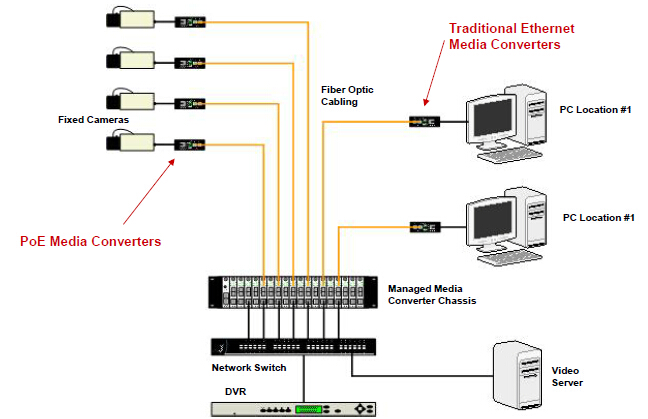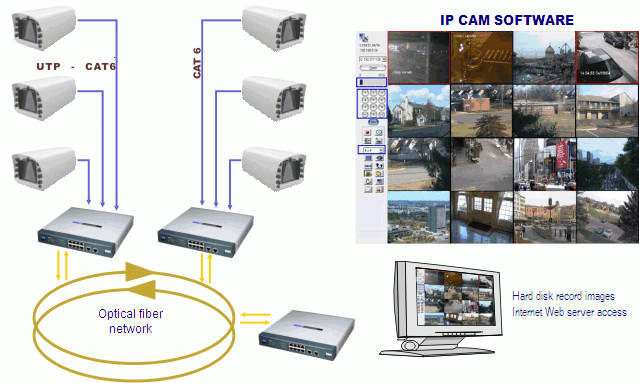Why CCTV Fibre Optic Cable is the Future of Fast Security Systems
Just How CCTV Cameras With Fiber Optic Output Enhance Long-Distance Tracking
CCTV cams equipped with fiber optic output represent a substantial advancement in long-distance surveillance innovation, using unparalleled advantages over typical systems. By leveraging the residential or commercial properties of light transmission via fiber optics, these cams make certain high-definition video quality remains intact across substantial ranges while properly mitigating electromagnetic disturbance. This technology not only improves photo quality however also improves installation processes and resource allocation. As we explore the implications of this technology, one should think about just how these improvements are reshaping the landscape of protection and monitoring systems in different applications.

Comprehending Fiber Optic Technology
Fiber optic technology is significantly made use of in long-distance surveillance applications because of its extraordinary capacity for information transmission. This modern technology utilizes thin hairs of glass or plastic fibers to send data as light signals, considerably reducing the depletion typically connected with traditional copper wires. The intrinsic homes of fiber optics enable the transmission of big volumes of information over considerable ranges without loss of high quality, making it a perfect choice for applications needing dependable interaction.
The concept of total interior representation promotes the effective transmission of light within the fiber, ensuring high transmission capacity and rate. Unlike electric signals in steel cords, fiber optics are unsusceptible to electromagnetic disturbance, enhancing the stability of information transmission. This characteristic is specifically important in settings with high levels of electric sound, such as industrial setups or city areas.
Furthermore, fiber optic cables are lighter and a lot more adaptable than their copper counterparts, which streamlines installment and decreases architectural lots. With their sturdiness and resistance to ecological factors, fiber optics are fit for outdoor applications, thus expanding the reach of keeping track of systems. Consequently, fiber optic modern technology is becoming a foundation in contemporary security solutions, efficiently attending to the obstacles of long-distance monitoring.
Benefits of Fiber Optic CCTV
Utilizing fiber optic innovation in CCTV systems uses countless benefits that enhance surveillance abilities. One of the main benefits is the capability to send high-def video clip over lengthy ranges without substantial signal destruction. Unlike traditional copper cable televisions, fiber optics can preserve video quality over comprehensive runs, making them optimal for big residential or commercial properties or remote monitoring places.
Furthermore, fiber optic cable televisions are less vulnerable to electromagnetic interference, which can distort signals in conventional systems. This ensures clearer images and continuous service, vital for safety tracking. Additionally, fiber optics are inherently much more protected, as intercepting signals calls for customized tools, hence supplying an additional layer of protection versus unapproved gain access to.
The light-weight and small nature of fiber optic cable televisions also streamlines installation, enabling less complicated transmitting with tight areas and decreasing total labor expenses. Their durability makes them immune to environmental variables such as wetness and temperature level changes, expanding the life expectancy of the security system.
Finally, fiber optic systems can sustain a higher number of cameras on a single network, maximizing resources and using scalability for future expansion. These advantages make fiber optic CCTV systems a superior selection for modern monitoring demands.
Comparison With Standard Systems
When comparing CCTV systems, typical setups commonly fall short in numerous key areas, specifically in regards to distance and signal integrity. Conventional coax systems typically deal with significant signal degradation over fars away, restricting effective tracking varies to approximately 300 feet (cctv fibre optic cable). Yet limit, picture quality diminishes, resulting in prospective unseen areas and reduced surveillance effectiveness
On the other hand, fiber optic systems keep signal honesty over a lot greater distances, typically surpassing a number of miles without loss of top quality. This is greatly as a result of their ability to transmit data as light signals, which are less susceptible to electromagnetic interference than electric signals used in conventional systems.
Additionally, typical systems need extra substantial maintenance and troubleshooting because of their vulnerability to environmental factors such as moisture and electro-magnetic noise. Fiber optic systems, alternatively, deal boosted resilience and lower maintenance prices, as they are less vulnerable to damages.
Applications in Long-Distance Surveillance
The advantages of modern-day CCTV systems in maintaining signal honesty over fars away open up a wide variety of applications for long-distance surveillance. One substantial application is in city security, where municipalities release fiber optic CCTV systems to monitor public spaces, boosting safety and deterring criminal task. These systems supply continuous, high-quality video clip feeds that are important for effective police and emergency situation reaction.
An additional crucial application is in commercial settings, where remote surveillance of producing processes and harmful areas is crucial. Fiber optic CCTV can stand up to severe settings and transfer information over long distances without loss of top quality, enabling real-time oversight and minimizing dangers to personnel.
In addition, crucial framework such as airports, railways, and pipes gain from long-distance CCTV monitoring. Safety groups can oversee large areas from systematized control areas, guaranteeing fast feedback to any events.
Additionally, in farming setups, farmers make use of long-distance CCTV to monitor crops and livestock, assisting to boost performance and security. In general, the flexibility and dependability of fiber optic CCTV systems make them vital throughout numerous sectors, enabling extensive surveillance services tailored to particular requirements.
Future Patterns in Monitoring Innovation
Exactly how will improvements in modern technology improve the landscape of security? The future of surveillance innovation is poised for significant transformation, driven by developments such as synthetic intelligence (AI), artificial intelligence, and side computer. These innovations allow real-time data evaluation, permitting fast identification of potential threats and boosted situational recognition.
AI-powered analytics will improve the accuracy of face acknowledgment systems, decreasing false positives and making it possible for a lot more effective tracking of people. The assimilation of Web of Things (IoT) tools will facilitate a smooth network of interconnected surveillance systems, boosting tracking capabilities throughout vast locations.
Another fad is the shift in the direction of cloud-based storage remedies, which use scalable information administration and accessibility. This will certainly allow companies to save huge amounts of video clip information without the restrictions of physical storage fence detection system space, while guaranteeing that details is quickly retrievable.

Verdict
In verdict, CCTV cams outfitted with fiber optic result represent a considerable improvement in long-distance surveillance capacities. As monitoring innovation continues to evolve, the fostering of fiber optic services will likely play a critical function in boosting protection throughout diverse applications.